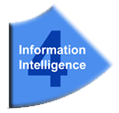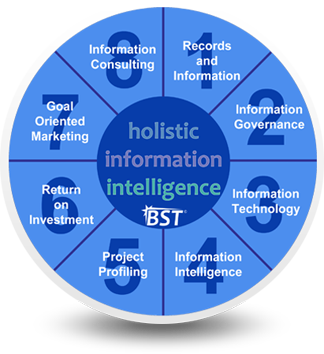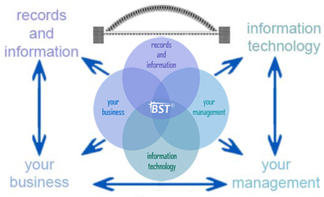
Information Intelligence brings together Records and Information Management professionals with those who manage Information Technology infrastructures in coordinated efforts with an organization's management and its business processes. Bridging communication between RIM and IT in cooperation with management and business, narrows the gap of these two worlds that have been apart for some time. The Records and Information, Your Management, Information Technology and Your Business (RIMITB) model works really well to solidify the concept.
BST RIMITB Model
Click to enlarge
-
records and information: identification of “all” organization records and information regardless of format and physical location
-
your management: management of organizations and the approach to their most valuable asset, “information”
-
information technology: information technology as an integral component of information solutions - breaking boundaries between IT and RIM
-
your business: business processes regarding records and information that are unique to each individual organization
The National Archives and Records Administration (NARA) defines Records Management as:
The planning, controlling, directing, organizing, training, promoting, and other managerial activities involved with respect to records creation, records maintenance and use, and records disposition in order to achieve adequate and proper documentation of the policies and transactions, and effective and economical management of agency operations.
Another definition of records management is the creation and implementation of systematic controls for records and information activities from the point where they are created or received through final disposition or archival retention, including distribution, use, storage, retrieval, protection and preservation.
Barclay T. Blair defines Information Governance as:
Information Governance (IG) encompasses sets of multi-disciplinary structures, policies, procedures, processes and controls implemented to manage information at an enterprise level, supporting an organization's immediate and future regulatory, legal, risk, environmental and operational requirements.
RSD - Your Information Governed, distinguishes the differences between Information Governance and Records Management:
Information Governance goes beyond the existing “state‐of‐the‐art” of records management applications. In the emerging information governance market, managing the lifecycle of the content not only covers the retention and disposition of the record but the complete management of the metadata of the record, tiering of content across storage platforms, security classification of the content during its lifecycle, data privacy attributes of the record during its lifecycle, and finally digital rights of the content when it goes outside the firewall (because that never happens). Essentially, information governance programs are a superset of records management programs and feature similar methodologies and processes.
Information governance is also more of an accountability program to enforce desirable behavior in the creation, use, archiving, and deletion of corporate information. It includes the lifecycle management practices to address eDiscovery readiness, information risk management, business information lifecycle management, and federated archiving. Information governance clearly defines the roles and responsibilities with detailed metrics and auditing. It requires a cross functional committee involving legal, compliance, business, and IT.
Unlike current records management solutions, information governance enables central management of retention policy and metadata, while supporting the enforcement of information governance policies across business functions, locations, and information silos. Information silos include both structured (databases and data warehouses) and non‐structured repositories (enterprise content management, document management, paper records etc.).
The Information Technology Association of America defines Information Technology as:
The study, design, development, application, implementation, support or management of computer-based information systems. The responsibilities of those working in the field include network administration, software development and installation, and the planning and management of an organization's technology life cycle, by which hardware and software is maintained, upgraded and replaced.
Information Technology also encompasses all forms of technology used to create, store, exchange, and use information in its various forms (data, voice messages, images, multimedia, and other forms).


